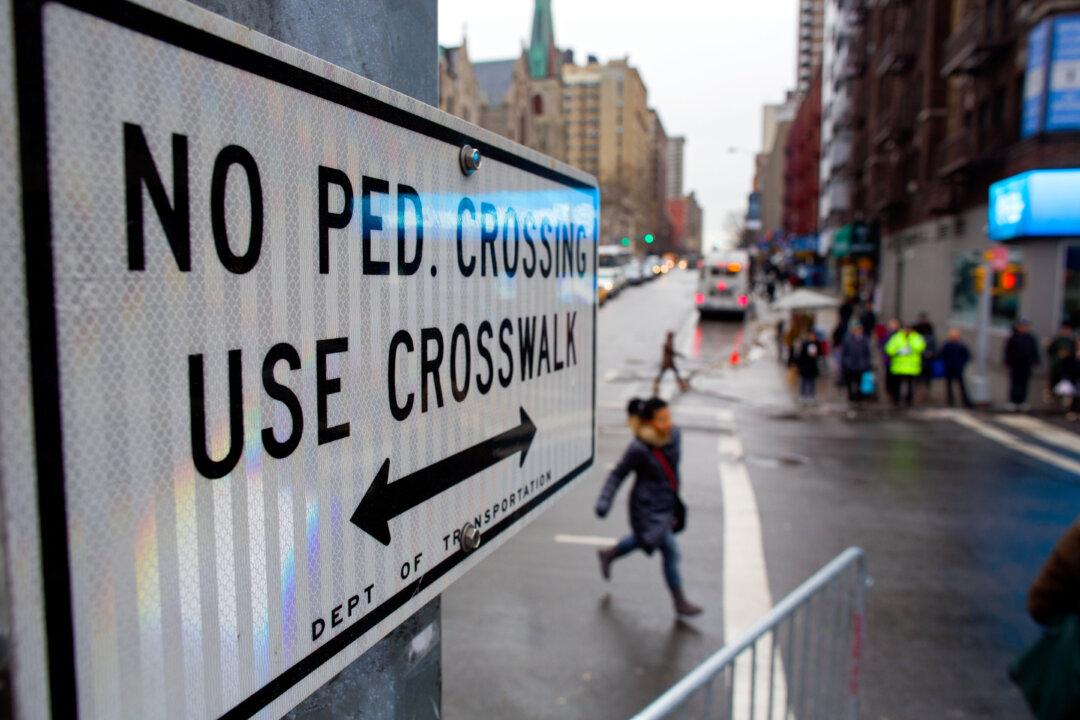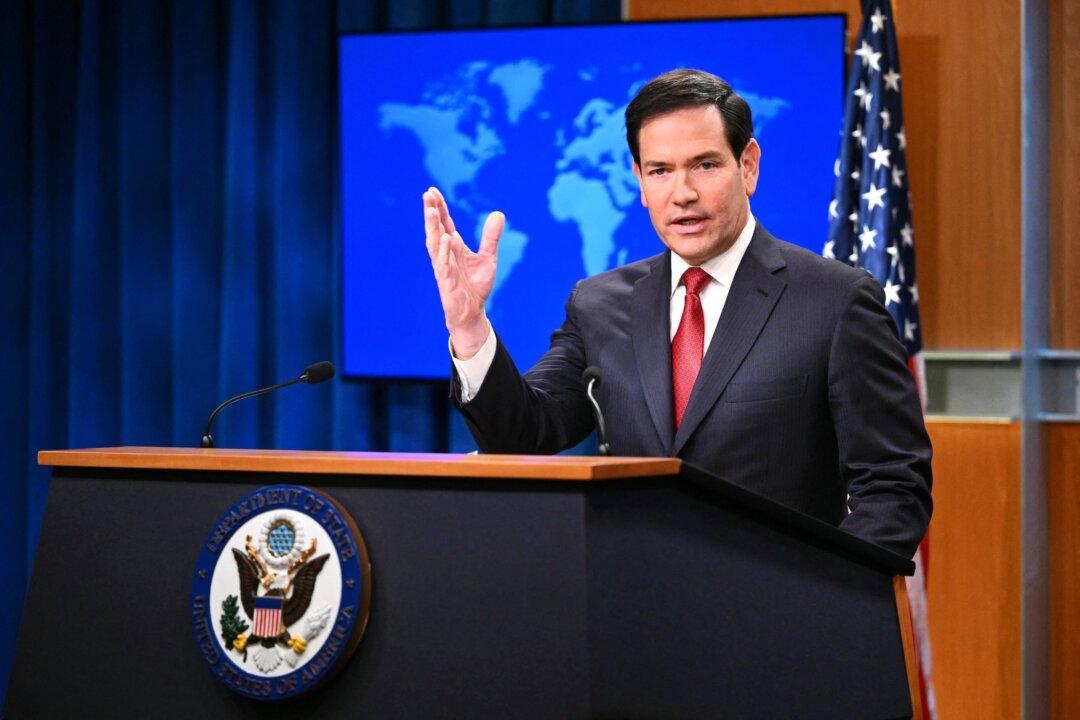NEW YORK—With a focus on street redesign and ticketing drivers, Mayor Bill de Blasio hopes to reduce traffic-related fatalities to zero in the next decade.
Situated just a block away from a dangerous Upper West Side intersection at West 96th Street and Broadway, de Blasio unveiled his Vision Zero Action Plan, which an interagency task force has worked on for the last month.
“We don’t accept the status quo in this town that leads to so many people losing their lives when we could have saved them,” de Blasio said.
Three pedestrians were killed within nine days on, or very close, to the Upper West Side intersection this January.
The mayor expressed optimism that all changes will come swiftly despite some items like additional traffic cameras needing approval from the state Legislature. West 96th Street, for example, will have a speed board installed this week, with other changes slated to begin early spring.
“We have to get as much as we can done this year,” de Blasio said.
Over 20 traffic-related fatalities have already occurred this year. On average, 250 New Yorkers are killed and 4,000 are seriously injured in traffic-related incidents every year. Other cities that have adopted Vision Zero policies, including Minnesota and Washington, have lowered traffic fatality rates 25 percent faster than the national average.
Good Design
Street redesign has long been an item pedestrian advocates have pushed for. Under the Bloomberg administration, 180 acres of roads were put to other uses like pedestrian plazas, and some advocates had been worried de Blasio would undo some of that work.
Now they’re convinced he won’t—the plan calls for extensive redesigning of 50 intersections and corridors every year.
“One surefire way the city can start saving lives is by fixing the most dangerous streets,” states Paul Steely White, executive director of the citizen activist organization Transportation Alternatives, in response to the mayor’s announcement. Wide streets make up 10 percent of the city’s road network, but they are where over 50 percent of pedestrian injuries occur, according to Transportation Alternatives.
The action plan also calls for creating 25 new slow zones, more speed boards, and many other measures like speed bumps and improved lighting.
Street redesigns over the last five years have already lowered injuries and fatalities in many areas across the five boroughs by 25 to as much as 88 percent, said Department of Transportation (DOT) Commissioner Polly Trottenberg.
For example, on the Queens side of the Pulaski Bridge, the DOT had installed new crosswalks, signals, and pedestrian islands, and simplified the complicated traffic crossing patterns. Injuries dropped 63 percent there in three years.
“We do know how to do this,” Trottenberg said. “We need to take the good work that we do and do it citywide.”
Expediting the Process
Manhattan Borough President Gale Brewer said unfortunately the Upper West Side had known how dangerous the intersection at West 96th Street and Broadway was for a very long time, but it was only after the three tragic deaths last month that action was taken.
“A lot of times, the [city] doesn’t know what exactly to do,” Brewer said. “But people in the communities know where the [dangerous] spots are.”
According to a DOT traffic engineer, it typically takes around two years to get a proposal to the community because of the time it takes to do all of the data collection. That’s on top of identifying the intersections or corridors to target.
But with community boards as the eyes and ears of city agencies, Brewer said, this process can be expedited a little.
“[The work needed] is not always a lot,” Brewer said. Sometimes the changes needed at an intersection are cosmetic, such as “a little paint, some new signage. That’s it.”
Brewer has already met with all the Manhattan community boards and compiled lists of dangerous spots for the agencies’ consideration. Now she’s working to bring senior centers and schools into the conversation.
Pedestrians and Jaywalking
Summons issued to jaywalkers have gone up 800 percent this year, but de Blasio and New York Police Department Commissioner Bill Bratton made clear jaywalking enforcement is not part of the plan. However, individual precinct commanders are still free to pursue the measure if it makes sense for the location.
The focus for NYPD will be on the drivers. Over the last five years, 70 percent of pedestrian fatalities involved speeding or inappropriate turning, Bratton said.
“[NYPD] will put the focus on where we can make the most impact the most quickly,” Bratton said.
NYPD will also be increasing personnel in its Highway Division to 263 officers (it has been as low as 190), and making sure every precinct has updated speed-detection technology.
Further Efforts
The Taxi and Limousine Commission (TLC) and City Hall have roles to play as well.
A taxi driver who kills or seriously injures a pedestrian currently only receives points as a way of enforcement. Only taxi drivers with six points are taken off the road, so many taxi drivers involved in pedestrian injuries or fatalities are free to continue driving.
TLC will create a safety enforcement squad, as well as a publicly accessible Honor Roll of safe, licensed drivers.
“Taxi drivers set the tone on our streets,” de Blasio said.
The Transportation and Public Safety City Council committees will be meeting to discuss Vision Zero next week as well. The plan includes a need for legislation on both the state and city levels, and constant updating to keep the plan innovative, the mayor said. For instance, the mayor wants to lower the citywide speed limit from 30 mph to 25 mph, which requires state action.
City Hall will regularly publish crash and safety data, and establish a permanent Vision Zero task force.
“Our lives are literally in each others’ hands,” de Blasio said.
The last component is funding, as White points out. Some intersections only require a new sign, but projects like the Times Square pedestrian plaza cost $27 million.
“Without the necessary funding for these projects, New Yorkers will continue to be killed and maimed in preventable crashes,” White stated, urging officials to ensure the funding for these projects would be available.
NYC Streets Metamorphosis from Streetfilms on Vimeo.
Vision Zero Action Plan
- Reduce citywide speed limit from 30 mph to 25 mph
- Implement 8, and create 25 more, neighborhood slow zones
- Double the number of speed boards
- Open NYPD’s TrafficStat to other agencies
- Investigate all crashes with critical injuries
- Modify precinct-level traffic plans to increase focus on pedestrian safety
- Legislation to increase penalties for taxi drivers who engage in dangerous behavior
- Pilot technology that alerts taxi drivers and passengers when they travel over the speed limit
- Pilot black box data recorders in TLC-licensed vehicles
- Explore technology to limit taxi drivers’ speeds, or reduce the fare when a driver speeds
- Create TLC safety enforcement squad
- Create a permanent Vision Zero Task Force to oversee implementation





